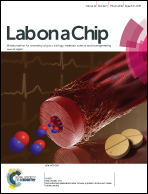Separation of motile bacteria using drift velocity in a microchannel
Abstract
Separation of certain bacteria from liquids is important in the food, water quality management, bioengineering, and pharmaceutical industries. In this study, we developed a microfluidic device for the hydrodynamic separation of motile bacteria (Escherichia coli) using drift velocity. We first investigated drift tendencies of bacteria and found that cells tended to move in a spanwise direction with similar velocities regardless of the flow rate. When the drift distance was small compared to the wetted perimeter of the cross section, the cells were not separated efficiently. We then investigated the drift phenomenon in more detail using a numerical simulation. Interestingly, the drift phenomenon was observed even without a wall boundary, indicating that drift was caused mainly by the interaction of moving cells with the background shear flow. Finally, we developed a microfluidic device to separate motile bacteria from tracer particles or less motile cells. By decreasing the channel height, the device could successfully separate motile bacteria from other particles or cells with a separation efficiency of about 40%. Connecting microchannels in a series was also found to be effective, which achieved the separation efficiency of about 60%. The knowledge obtained in this study will facilitate the development of other microfluidics devices for use with bacteria.


 Please wait while we load your content...
Please wait while we load your content...